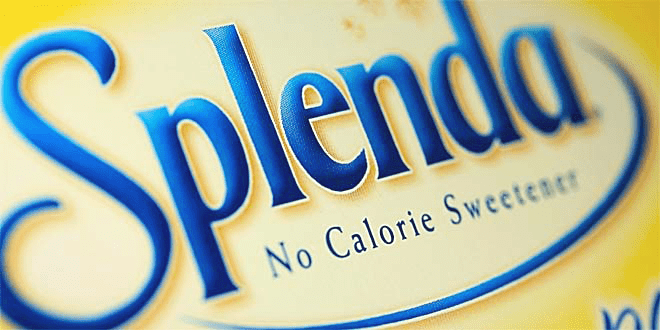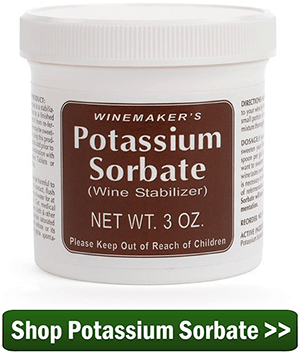 My question is in regards to Splenda as a sweetener. I belong to two wine making groups from Yahoo Groups and on occasion Splenda comes up as the subject. There are both pros and cons regarding Splenda as a sweetener. Would very much appreciate hearing your opinion on using Splenda to sweeten wines.
My question is in regards to Splenda as a sweetener. I belong to two wine making groups from Yahoo Groups and on occasion Splenda comes up as the subject. There are both pros and cons regarding Splenda as a sweetener. Would very much appreciate hearing your opinion on using Splenda to sweeten wines.
Thank you.
Melinda
_____
Hello Melinda,
This is definitely an area of home wine making that has yet to be covered in any wine making books or other instructional materials that cover how to make your own wine at home.
Splenda can be used to sweeten a wine just like any other sugar, just as long as you are happy with the flavor results, however there is some caution that needs to be taken…
Splenda is actually made from sugar that has had its molecular structure changed. This is done so that it can not be broken down and assimilated by the human body. It simply passes through the body, providing no nutritive value.
The same holds true with respect to Splenda in a fermentation. The yeast are unable to metabolize the Splenda and turn it into alcohol because of its molecular structure.
Where an issue comes in for winemakers is when time is brought into the equation. While Splenda does not break down over the course of a few days, if given more time, the leftover enzymes from a fermentation will eventually break down a portion of the Splenda into a fermentable carbohydrate.
 This is exactly the situation you run across when you bottle your wine with Splenda. While the wine bottles sit on the shelf month-after-month, the natural enzymes in the wine will slowly start breaking down the Splenda. This in turn will allow any residual yeast to start nibbling on it and fermenting it. The result is CO2 gas slowly building up in the bottle until the wine cork stoppers eventually pushes out. The slightest amount of fermentation activity can cause quite a bit of gas or pressure in the wine bottle.
This is exactly the situation you run across when you bottle your wine with Splenda. While the wine bottles sit on the shelf month-after-month, the natural enzymes in the wine will slowly start breaking down the Splenda. This in turn will allow any residual yeast to start nibbling on it and fermenting it. The result is CO2 gas slowly building up in the bottle until the wine cork stoppers eventually pushes out. The slightest amount of fermentation activity can cause quite a bit of gas or pressure in the wine bottle.
The take-away from this is that, yes, you can use Splenda to sweeten your wines just like you would with regular sugar, but you should also use a wine stabilizer such as potassium sorbate to eliminate any chance of re-fermentation within the wine bottle. Treat the Splenda as if it were real sugar.
Happy Wine Making,
Ed Kraus
—–
Ed Kraus is a 3rd generation home brewer/winemaker and has been an owner of E. C. Kraus since 1999. He has been helping individuals make better wine and beer for over 25 years.

Your answer is correct, it will work fine with no hint of continued fermentation in a white wine as long as the correct amount of so2 is added after cold stabilization and filtering. With sugar there is a chance of re-activation if not enough so2 was applied.
When using splenda to preserve food, it has been noted that it can leave an odd slightly bitter taste that grows stronger with the passage of time. I would be aware of this possible impact when using splenda.
Jeanne,
I have heard the same thing. The Splenda can break down over time and impart “off” flavors to the wine.
I use sugar for fermentation, then a little erythritol (or xylitol) to sweeten to taste when bottling. Works well for me. Not sure whether the yeast can break it down like Splenda, but I doubt it.
One thing that I don’t see mentioned often that we do with our wine ( either home made or purchased ), is to sweeten to taste just before consumption. You can often “salvage” a bottle of not so good bargain wine with this method. You also get the exact “sweetness” you want because it is sweetened at consumption and does not change with aging. You can sweeten by the bottle ( after taste testing a small amount ) or by the glass. Sweetening by the glass gives multiple consumers the chance to sweeten by their individual tastes. Any sweetener can be used without concern about long term chemistry effects. There is also much less risk of the second fermentation after bottling with this method.
Ed,
You’re too kind to splenda. I use it daily for coffee, tea etc. and occasionally wine, by the glass like mentioned by Mike above. Splenda has a definite after taste that takes getting used to. Many people flat out don’t like it. Because of this I would never sweeten a batch or even a gallon with it, mainly because I share my wine with many people.
That said, I like a semi-sweet wine and continuously add small amounts of sugar to keep a reading of 1.005 – 1.012 (With this method, using yeasts like Lalvin EC-1118, 71B-1122 or Red Star Cuvee you will get high alcohol batches). I’m not worried about re-fermentation because I bottle in 1 gal jugs and keep a loose lid on them. I’ve taken readings on 6-12 month bottled and they rarely drop more than one point.
I’ve heard of people using Stevia long ago it’s from A plant,
Xylitol can be derived from Birch tree’s ,
but I’m not certain if these are healthy or not?
tricking the body making Insulin and all that who knows?
I like bone dry wine anyways (and not much of a sweet tooth type of person either)
Stag horn Sumac wine Fermented dry has a sweet(ener) taste to it. (not that I eat em)
(anise seed wine dry is sweet from what I hear that’s estrogenic opp’s )
Make a simple syrup to add to glass of wine if your guest wants a sweeter wine. I like my wines dry, so I make it for me, if company likes sweet, I add a little syrup to sweeten it for them, every one is happy.
How about STEVIA, a natural sweetener derived from the leaves of the Stevia plant. I have used it in place of sugar many times but never in wine.
Roger, while I have not used Stevia myself to sweeten wine, we have heard from many of our customers that have. We actually have a blog article about this very subject that will provide additional information.
Sweeten With Stevia
http://www.eckraus.com/blog/sweeten-your-homemade-wine-with-stevia
Be aware of the side effects of splenda (sucralose). I made 2 batches of wine that came out very tart and I used splenda to sweeten it up a bit when I went to drink it. After a while, I started to feel dizzy and really lousy. I went to several doctors to with no solution to my symptoms. It finally dawned on my that the only change was the wine with splenda. I stopped drinking it and my problems went away. I read about the side effects of sucralose and every one of my symptoms were listed. Beware.
I haven’t tried Splenda, but I did make some Blueberry wine for a friend. Not wanting to use that much sugar I experimented with Stivia. My friend like sweet wines so I didn’t think twice about Stivia. What I used was from WalMart. It was a powder form. I tasted it as I added it. I used 15 Tbls for 6 gallons of wine. It had a vanilla after taste at first but after sitting in the bottle for a few weeks it lost its flavor. Not sure I’d use it again.
Ok, what about Stevia ?
Ron, There is nothing wrong with using stevia to sweeten a wine at bottling time. I would take a look at the article posted below.
Can I Sweeten My Wine With Stevia
https://blog.eckraus.com/sweeten-your-homemade-wine-with-stevia
Please remember that Splenda is bulked up with maltodextrin. That, not a fermentation of sucralose is what you observe causing CO2 buildup.
I use Splenda in my ice tea and for general sweetening all the time and love it.
I will even open a bottle of wine and add a Splenda to perk up the fruit flavors in a very dry wine. It’s OK.
But, when I sweeten with Splenda and then bottle, it is just not nearly as good. Gets worse the longer it is in the bottle too…or so it seems to me.
Ed
i have not used Splenda but have used Sweet and Low for many years. rather than sweeten (<1% equivalent) with sugar, we prefer to use the S&L. It has been very effective and will keep the wine in the right range for many years storage.
Are there any things that you know that we should do if we are using S&L?
There is nothing special to using Sweet and Low. The one thing you need to watch out for is that Sweet and Low will drift to the bottom of the bottle. Not as a dusting or anything like that, but as a liquid. The Sweet and Low will have a tendency to collect at the bottom if given enough time. This is because it will not bond well with the wine. It wants to stay separated.